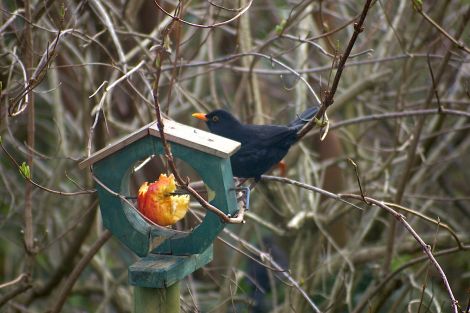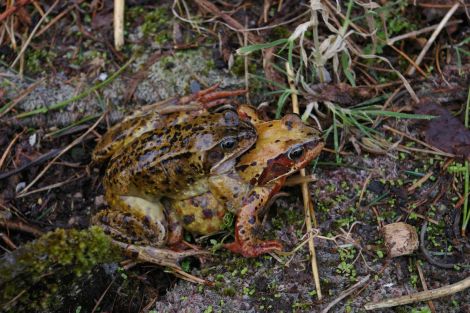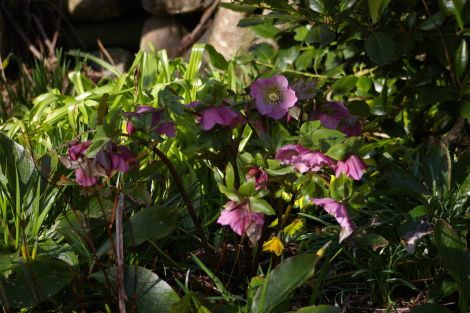Four Seasons / Four Seasons – Spring 2015
GARDEN fauna usually only feature in gardening columns when they become troublesome: rabbits ring-barking trees, cabbage whites decimating the kale yard, otters cleaning out the carp pond, slugs gnawing their way through a forest of lettuce seedlings, and weevils – in the dead of night- laying their eggs into the crowns of primroses. Headaches all of them, and not the fauna I’ll concern myself with today.
Shetland’s housing shortage is well documented, but the local media seem to have drawn a veil of secrecy over a far worse accommodation crisis.
The brown or common frog Rana temporaria is one of the first heralds of spring. It comes in a great variety of colours, including golden green, yellow, even pale orange. Their nocturnal croaking, rising from hundreds of throats, sounds like the purring of a giant cat to me, but like somebody driving a quad on the hill above the house to my crofting husband.
Seeing the frogs return is a great March spectacle. But this year, Lea Gardens’ generously sized pond was so overcrowded (at times there seemed to be more frog than water), that desperate couples could be found mating and depositing spawn on dry land.
Frogs, frogs everywhere, hopping along paths, clambering over dykes, hitching rides on the dog’s tail. I’ve never seen the likes of it. What is the amphibian world coming to?
The common or garden frog had covered the entire pond surface in spawn (walking on water became a distinct possibility) and three weeks later, what was cloudy has turned black, as millions of tiny tadpoles (free to good homes) have started to wriggle enthusiastically.
Raising frogs from tadpoles is a much loved childhood pastime, but success rates tend to be slim, for one simple reason. As soon as tadpoles start to grow their first pair of legs, they become carnivorous and, if there’s nothing else to eat, they’ll eat each other.
Become a member of Shetland News
Preventing cannibalism couldn’t be simpler. They love to snack on cat biscuits thrown into the water and need a frog “ladder”, a plank or something similar, to help them out of their bucket or basin and onto dry land once they’re ready to start their terrestrial existence.
Frogs are said to be good for the garden, but sadly, they do not, as many believe, eat slugs. They are insect eaters, gobbling up anything that can fly and that must include a good many undesirables such a carrot and cabbage root-fly.
Many garden birds are brilliant insectivores and/or get rid of weed seeds by the ton. Shetland wrens flit in and out of dry-stone dykes while goldcrests search for insects in the Japanese larches as I write.
It is of course the gardener’s duty to bring our avian friends safely through the winter, and it is a joy rather than a chore. The garden has a variety of ‘dining areas’, wire cages for fat-balls, a seed dispenser, a traditional bird table and a device for spearing wrinkled apples.
They’re visible from my kitchen window and my heart leaps when, amongst the humdrum of starlings, sparrows and blackbirds, something a little out of the ordinary crops up. There are always a few robins, a couple or more of chaffinches, but I had never encountered a hawfinch before.
It is near on twice the size of a chaffinch and sports an impressively pale blue-grey beak. Its mandibles are said to exert a pressure of over 50kg and it is has been described as “a nutcracker on wings” in Collins Bird Guide.
She (a female) gorged enthusiastically on all we offered, including small wild hazel nuts still in their shells, then left without so much as a by-your-leave. A dunnock, pretending to be a sparrow, behaved in much the same way.
“My toe hurts, my toe hurts” was a call I hadn’t heard since last summer and one that signalled the return of our breeding pair of collared doves.
They alighted in the downy birch outside my window, looking so very elegant and graceful with their pale fawn-grey plumage and dark-tipped fanned wings.
I’m often asked how to encourage wildlife into the garden. The answer is simple. Grow a wide range of flowering and fruiting plants from as many different genera as possible – herbaceous ones, woody ones, evergreen and deciduous ones. The wildlife both desirable and undesirable will arrive of its own accord. If you want frogs, all you need is a large puddle that doesn’t dry out.
And suddenly it’s Voar. After this long, wet and windy winter I’m sure the arrival of spring was never more eagerly awaited. But when exactly did it arrive?
I’m not sure. Was it the first willow catkins ripening their pollen? The nodding of golden daffodils? The flowering of the flowering currants? The first bumblebees on the wing? The first shalders striding across the lawn? The blackbirds’ melodious song before dusk?
All of these and many more, such as an old rheumatic cat finding a sheltered spot to soak up the sun, and that incomparable spring evening light on the Lenten roses.
Rosa Steppanova (Lea Gardens)
Become a member of Shetland News
Shetland News is asking its many readers to consider paying for membership to get additional features and services: -
- Remove non-local ads;
- Bookmark posts to read later;
- Exclusive curated weekly newsletter;
- Hide membership messages;
- Comments open for discussion.
If you appreciate what we do and feel strongly about impartial local journalism, then please become a member of Shetland News by either making a single payment, or setting up a monthly, quarterly or yearly subscription.
































































